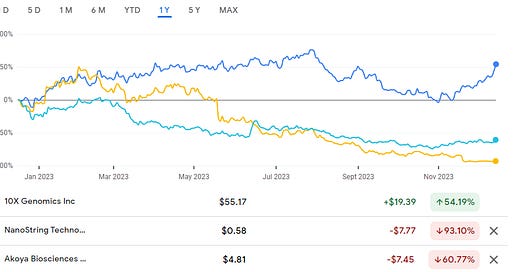Rumours suggest that 10X Genomics will release the highly anticipated Visium HD product in Q1 2024.
This new version of the Visium platform, which has already gained some market share in spatialomics, is expected to offer significantly higher resolution than its predecessor. This enhanced capability will enable researchers to identify poly-A transcripts expressed in individual cells within tissue biopsies, opening up new avenues for spatial biology research.
The Visium version 1, despite securing a significant portion (80-90%) of the spatialomics market share, hasn't translated into substantial financial gains for 10X Genomics. The primary setback was its lack of resolution, proving insufficient for applications requiring single-cell resolution in biopsy samples. This limitation fueled anticipation for the Visium HD, which promises improved resolution through the integration of the CytAssist instrument for sample preparation. This advancement is expected to enable researchers to delve deeper into discovering cell-specific transcript expression within tissue biopsies, a realm previously unexplored due to resolution constraints.
While Visium has been primarily utilized for biomarker discovery, it is not expected to become a mainstay clinical assay.
One reason Visium version 1 didn't witness a surge in uptake was its perceived limitation in long-term clinical assay usage. Instead, it found more favor in the discovery phase of cell types and biomarkers. Researchers seem keen on leveraging Visium's poly-A spatial transcriptomics to identify cell types in tissue biopsies and pinpoint the transcribed mRNAs defining these different cell types. Subsequently, the plan appears to involve incorporating these biomarkers into a 10X Genomics Xenium panel for further exploration.
Interestingly, social media polling indicates a higher interest in the Xenium compared to Visium HD. This shift in attention could potentially influence market dynamics and product strategies for 10X Genomics.
Competition in the spatialomics space is limited to Curio Bio and NanoString.
Assessing the competitive landscape, Curio Bio and NanoString emerge as the primary contenders with similar products to Visium. Curio Bio's SEEKER, stemming from scientific work at the Broad Institute, stands out as an early version resembling Visium HD that's available for purchase presently. Its instrument-free design adds to its appeal, making it an attractive option for many organizations' initial experiments.
Despite Curio Bio SEEKER's promise, uncertainties loom over its future trajectory. The possibility of acquisition by a larger entity like Thermo Fisher could significantly enhance its global reach and competitiveness against 10X Genomics. However, 10X Genomics' patent infringement lawsuit against Curio Bio introduces a cloud of uncertainty, although experts are questioning the validity of the litigation. It could be that the 10X v. Curio litigation only becomes financial burden for both parties, but doesn’t involve any FTO issues for Curio Bio.
The potential acquisition of Curio Bio by a larger company like Thermo Fisher could significantly expand its reach and competitiveness.
10X Genomics has filed a patent infringement lawsuit against Curio Bio, but if experts are to be believed in that the litigation is unlikely to hold merit, then Curio Bio SEEKER is here to stay for the long-term. This could mean that we would have a real competitor to TXG 0.00%↑ Visium’s product line.
In conclusion, the anticipated release of Visium HD is poised to further solidify 10X Genomics' position as a leader in spatialomics. The enhanced resolution and sample preparation capabilities of this new platform are expected to open up new frontiers in spatial biology research. However, the ultimate impact of Visium HD will depend on its adoption by researchers and its integration into clinical workflows.
What could this mean for TXG, NSTG, AKYA and other related stocks?
Read the analysis past the paywall…




